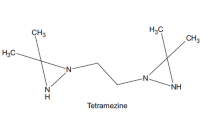Abstract
The plasma protein binding of the new antipsychotic risperidone and of its active metabolite 9-hydroxy-risperidone was studied in vitro by equilibrium dialysis. Risperidone was 90.0% bound in human plasma, 88.2% in rat plasma and 91.7% in dog plasma. The protein binding of 9-hydroxy-risperidone was lower and averaged 77.4% in human plasma, 74.7% in rat plasma and 79.7% in dog plasma. In human plasma, the protein binding of risperidone was independent of the drug concentration up to 200 ng/ml. The binding of risperidone increased at higher pH values. Risperidone was bound to both albumin andα 1-acid glycoprotein. The plasma protein binding of risperidone and 9-hydroxy-risperidone in the elderly was not significantly different from that in young subjects. Plasma protein binding differences between patients with hepatic or renal impairment and healthy subjects were either not significant or rather small. The blood to plasma concentration ratio of risperidone averaged 0.67 in man, 0.51 in dogs and 0.78 in rats. Displacement interactions of risperidone and 9-hydroxy-risperidone with other drugs were minimal.
Similar content being viewed by others
References
Claus A, Bollen J, De Cuyper H, Eneman M, Malfroid M, Peuskens J, Heylen S (1992) Risperidone versus haloperidol in the treatment of chronic schizophrenic inpatients: a multicentre double-blind comparative study. Acta Psychiatr Scand 85:295–305
Contin M, Riva R, Albani F, Perucca E, Lamontanara G, Baruzzi A (1985) Alpha1-acid glycoprotein concentration and serum protein binding of carbamazepine and carbamazepine-10, 11 epoxide in children with epilepsy. Eur J. Clin Pharmacol 29:211–214
Gelders YG, Heylen SLE, Vanden Bussche G, Reyntjens AJM, Janssen PAJ (1990) Pilot clinical investigation of risperidone in the treatment of psychotic patients. Pharmacopsychiatry 23:206–211
Huang M-L, Van Peer A, Woestenborghs R, De Coster R, Heykants J, Jansen AAI, Zylicz Z, Visscher HW, Jonkman JHG (1993) Pharmacokinetics of the novel antipsychotic agent risperidone and the prolactin response in healthy subjects. Clin Pharmacol Ther 54:257–268
Janssen PAJ, Niemegeers CJE, Awouters F, Schellekens KHL, Megens AAHP, Meert TF (1988) Pharmacology of risperidone (R 64766), a new antipsychotic with serotonin-S2 and dopamine-D2 antagonistic properties. J Pharmacol Exp Ther 244:685–693
Kremer JMH, Wilting J and Janssen LHM (1988) Drug binding to human alpha-1-acid glycoprotein in health and disease. Pharmacol Rev 40:1–47
Kristensen CB (1983) Imipramine serum protein binding in healthy subjects. Clin Pharmacol Ther 34:689–694
Leysen JE, Gommeren W, Eens A, de Chaffoy de Courcelles D, Stoof JC, Janssen PAJ (1988) Biochemical profile of risperidone, a new antipsychotic. J Pharmacol Exp Ther 247:661–670
MacKichan JJ (1989) Protein binding drug displacement interactions. Fact or fiction? Clin Pharmacokinet 16:65–73
Mannens G, Huang M-L, Meuldermans W, Hendrickx J, Woestenborghs R, Heykants J (1993) Absorption, excretion and metabolsm of14C-risperidone in humans. Drug Metab Dispos 21:1134–1141
McElnay JC, D'Arcy PF (1983) Protein binding displacement interactions and their clinical importance. Drugs 25:495–513
Meuldermans W, Hendrickx J, Mannens G, Laorÿsen K, Janssen C, Bracke J, le Jeune L, Lauwers W, Heykants J (1994) The metabolism and excretion of risperidone after oral administration in rats and dogs. Drug Metab Dispos (in press)
Pacifici GM, Viani A (1992) Methods determining plasma and tissue binding of drugs. Pharmacokinetic consequences. Clin Pharmacokinet 23:449–468
Pacifici GM, Viani A, Taddeucci-Brunelli G, Rizzo G, Carrai M, Schulz H-U (1986) Effects of development, aging, and renal and hepatic insufficiency as well as hemodialysis on the plasma concentrations of albumin and alfa-1-acid glycoprotein: implications for binding of drugs. Ther Drug Monit 8:259–263
Sjöholm I, Ekman B, Kober A, Ljungstedt-Påhlman I, Seiving B, Sjödin T (1979) Binding of drugs to human serum albumin: XI. The specificity of three binding sites as studied with albumin immobilized in microparticles. Mol Pharmacol 16:767–777
van Beijsterveldt L, Geerts R, Leysen J, Megens A, Van den Eynde H, Meuldermans W, Heykants J (1993). The regional brain distribution of risperidone and its active metabolite 9-hydroxy-risperidone in the rat. Psychopharmacology (in press)
Zini R, Riant P, Barré J, Tillement J-P (1990) Disease-induced variations in plasma protein levels. Implications for drug dosage regimens (Part I). Clin Pharmacokinet 19:147–159
Author information
Authors and Affiliations
Rights and permissions
About this article
Cite this article
Mannens, G., Meuldermans, W., Snoeck, E. et al. Plasma protein binding of risperidone and its distribution in blood. Psychopharmacology 114, 566–572 (1994). https://doi.org/10.1007/BF02244986
Received:
Revised:
Issue Date:
DOI: https://doi.org/10.1007/BF02244986




